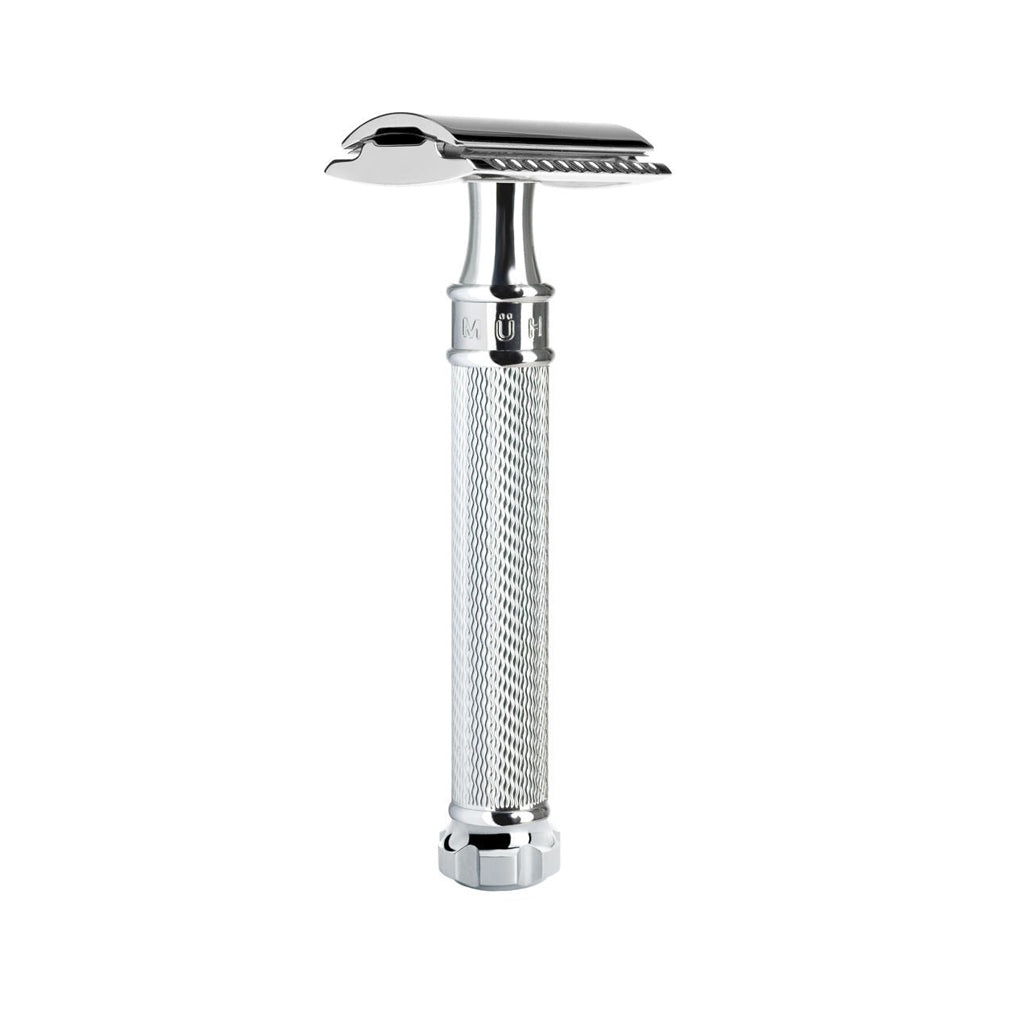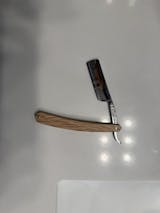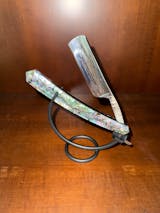The history of the safety razor began in the early 1900's and is making a big comeback. As they say history repeats itself. By some counts, the average man spends over 3,000 hours of his life shaving. People have always sought a smooth and close shave, and in pursuit of that goal, traditional wet shaving has lately been steadily increasing in popularity—especially with the double-edge safety razor.
Though the safety razor lapsed in popularity over the last 50 years in favor of convenient cartridge razors, men are becoming more interested in returning to one of the razor's most revolutionary innovations.

When was the double-edge safety razor invented?
There were a handful of types of “safety razors” before King Camp Gillette invented and then patented his double-edged safety razor in 1904. This variation of safety razor is a revolutionary innovation because it was the first time a blade was made to be disposable, and it was the first such razor blade to have two sharp edges.
How did the safety razor become popular?
Gillette's safety razor was solidified as the dominant product on the American market when the U.S. military issued Gillette shaving kits to all its soldiers during the first World War. After the war, the soldiers took home their razor handles and kept them permanently, now only having to buy the disposable blades.
Why are safety razors double edged?
A safety razor blade comes in one piece but has two sharp edges, and once it’s fastened on top of the handle, a man can shave using either side before having to rinse, saving time. He rinses his razor half as often within a single shave, which also means that the blade stays sharper and lasts longer.
The double edge safety razor designed by King C. Gillette was not the first razor to place the blade perpendicular to the razor handle (That was William S. Henton in 1847), but that is an essential design element for including a blade with two sharp edges.
Who made the first safety razor?
The term “safety razor” refers to a protective guard—a device situated between the blade and the skin that is intended to reduce injury. The earliest blade protective guard was an innovation of the straight razor and was created by Jean-Jacques Perret in 1762. It added a wooden sleeve that slid over the blade.
Perret wasn’t a barber by trade; he was a cutler. He drew inspiration for his first safety razors from a carpenter’s plane, which is a wood-cutting tool with a similar protective device.
Perret advertised his blade guard not as a tool that will help to avoid nicks and cuts but as one that will prevent a man from accidentally removing a portion of his ear; his safety guard only exposed the blade’s sharp edge, and the rest was covered by the wooden sleeve. No deep cuts would be possible.
When did people start using safety razors?
Perret’s advent of the guard onto the straight razor in 1762 reduced the need of visiting a professional barber for every shave. It allowed more ordinary men to shave at home because they were more confident they wouldn’t hurt themselves.
There were still chores associated with shaving at home: the blade would still need to be stropped before use and every so often honed by a cutler. Still, shaving at home was seen as easier than going to a barber and was becoming increasingly popular. Plus, the safety razor is easier to travel with than a straight razor.
When was the first disposable blade invented?
The addition of Gillette’s DE razor in 1904 finally rendered obsolete the processes of having your blades stropped and honed. The blade was disposable for the first time. Dull or rusty blades were discarded and replaced. A man could do everything himself.
Gillette sold 12 blades in a pack for a dollar. His customers bought the handle one time and bought the replacement blades as many times as was necessary. Many customers would install their replacement blades after a single shave because they were so inexpensive.
Gillette's product became so dominant that in many houses built before 1970, the medicine cabinets even had a slot to discard the disposable razor blade.
Didn't people cut themselves by changing the razor blades?
In 1923, Jacob Schick patented the injector blade—blades stored in an injector device that would be inserted directly into the razor. People were inadvertently cutting themselves by changing out disposable blades, and Schick's idea was to prevent people from handling the razors directly.
By introducing his product to the market, Schick Razors basically called out a deficiency in Gillette's model. Gillette eventually released his own model of in 1947.
Schick's injector blades just had one edge by design, though he was not the first to sell a single edge safety razor. The Gem Cutlery Company sold them as early as 1898, though they didn't have them. That particular safety razor featured a 4-centimeter segment of a straight razor.
Schick was an army officer who allegedly hated heating water which is a basic requirement of traditional wet shaving, so he invented the first electric razor, which he patented in 1930.
Have safety razors always had stainless steel blades?
When Gillette introduced his first safety razor to the market, it had a carbon blade, which was prone to rust. That created another reason, in addition to the blade dulling, that the razor blades would have to be replaced.
In 1962, a British company called Wilkinson Sword began to sell the stainless steel blade which didn’t rust nearly as quickly as the carbon blade.
Wilkinson’s blades became very popular among British and European markets and then became popular in the U.S., so Gillette and other large American brands had to also make the stainless steel blade their standard blade.
Gillette's patent application for the stainless steel blade was actually accepted in 1959—before Wilkinson first began to sell them—so Wilkinson had to send them royalties for every unit sold.
It was a smart financial decision for Gillette to refrain from selling the stainless blades because their customers had to dispose of the carbon blades more often, which meant they were buying more, and the royalties provided additional revenue.
Because of the enduring popularity and high quality of stainless steel, Gillette was legally accused of exploiting customers by holding the patent for stainless steel blades but not producing or selling them.
Cartridge razors are a modern evolution of the safety razor
In 1970, Wilkinson introduced what they called the "bonded shaving system" in which razor blades would be embedded in disposable plastic cartridges to be attached to the top of a razor handle. It was the first two-piece safety razor.
The cartridge razor system requires a single edge blade. You throw away everything that's not the handle, and with a double edge razor, you replace only the blade.
Wilkinson's original cartridge had a single blade, but many competing models began to spring up. Gillette immediately introduced cartridges to their catalog. Gillette's invention was the first model that had two blades and they called it the "twin-blade Trac II."
Gillette claimed their new twin blade razor gave a closer shave than Wilkinson's single blade. They said the first blade cut the facial hair and the second blade pulled out the follicle, which also appeared to slow the overall hair growth. This logic became universally accepted, and some other cartridge razors even featured up to five blades.
Soon after the advent of the cartridge razor, in 1977, Gillette introduced the first safety razor with a pivoting head. It was an innovation to their twin blade razor, and it allowed the head of the razor to tilt back and forth, better following the contours of the face.
When did the entire razor become disposable?
In 1974, Bic introduced disposable razors, which differed from Wilkinson's 1970 model only in that the whole thing could be discarded. Because of territorial patenting disputes, Gillette actually got disposable razors on the market before Bic did.
Gillette named their new disposable razors "Good News," and one of their quick innovations was that they added an aloe strip above the blade, which supposedly made a better shave for sensitive skin.
Modern cartridge razors are similar and are the most popular kind of safety razor today. Gillette and Bic are still among the most popular brands.
Is the cartridge system the most popular approach to shaving today because it's best?
In its enduring popularity, the cartridge system has been advertised as fitting for everybody. It's easy to use, and one size fits all. In reality, the cartridge blades don't specifically suit anybody.
With a double edge razor, since the blade itself is the only interchangeable part of the razor, you can choose the blade that best suits your hair and skin type. It allows men with specific shaving preferences—like wanting to protect their sensitive skin or have a very close shave for their coarse hair—to better control what they get out of their shave.
Creating the best shaving experience for yourself is ultimately just about understanding which type of blade suits you best. Safety razors with only disposable razor blades—not entire cartridges—offer options for the type of blade, with varying degrees of the closeness of shave.
Another downside of a cartridge razor is that the shaving cream applied to the skin prior to the shave clogs the blades and can get in the way of a clean shave. That's not a problem with non-cartridge safety razors or any device with just a single razor blade.

What is a slant bar safety razor and is it still around today?
Slant bar razors —a razor blade that is positioned at a slight angle and even has a slight curve—is popular among men with coarse and thick hair such as the Merkur 37 heavy duty slant bar double edge safety razor and Merkur Futur Adjustable Safety Razor. It's said to cut more easily than straight blades. It's the same reason the cartoon image of the guillotine has a razor blade that is so dramatically angled.
The first slant bar razor design was patented by Thomas Wilde in 1905, and while they were mildly popular at the time, that popularity has endured, is still available, and is cherished by wet shaving aficionados.

Different types of guards for double edge safety razors
Another variation is the open comb guard, which is a guard that exposes the DE safety razor blades more than its more standard counterpart, the closed guard.
Among users of double edge razors, the open comb guard is most popular among men with large amounts of facial hair who are interested in shaving a lot of it. The hair doesn't get caught in the blade because more of it is exposed.
A culture shift...
An increasing number of men are interested not in a fast, transactional shave that above all else prioritizes convenience but rather a high-quality, sometimes slower, and more mindful traditional wet shaving experience with a DE safety razor that delivers those needs and is becoming more popular because of it. For more information on traditional wet shaving visit our shaving frequently asked questions and tips.















